Exploring the Versatility of John Deere Forks


Key Insights
Overview of the Topic
John Deere forks are integral tools in both agriculture and industry, designed to maneuver heavy loads with efficiency and precision. These forks, often attached to various John Deere machinery like tractors or skid steers, come in multiple types tailored for specific tasks. Whether it’s lifting hay bales, moving pallets, or handling other materials, understanding the unique characteristics of these forks ensures optimal functionality in diverse settings. This article will provide an in-depth exploration of the designs and applications of John Deere forks, including insights into their maintenance and latest technological innovations.
When it comes to functionality, John Deere forks stand out due to their compatibility with a wide range of machinery. Each fork type has its purpose, designed meticulously for performance, strength, and ease of use. As agricultural practices evolve, the need for robust, easily operable equipment that can withstand the rigors of farm life has never been greater. Therefore, delving into the versatility and adaptability of these tools not only equips professionals with necessary skills but also enhances overall productivity in their operations.
Importance in Agriculture/Horticulture/Agronomy
The significance of John Deere forks cannot be overstated. In the realm of agriculture and horticulture, these tools facilitate a variety of operations that would otherwise be impractical or even impossible. For farmers, time is of the essence. Efficient material handling can save countless hours during harvests or logistical activities. For example, specialized forks can make it easier to gather and maneuver fragile crops without damage, preserving quality and minimizing waste.
On the agronomy side, John Deere forks allow for quick inspection or modification of materials or equipment on-site. They enable ease of adjustment to irrigation systems or quick transitions between planting and harvesting methods. Essentially, these forks are not mere accessories; they are indispensable in streamlining operations, allowing farmers to adapt quickly to changing agricultural needs.
"John Deere forks are not just tools; they are key partners in the quest for agricultural efficiency and productivity."
Sustainable Practices
Eco-Friendly Techniques
Sustainability has taken center stage in today’s agricultural discourse, and John Deere is spearheading several initiatives that underscore eco-friendliness. Farms utilizing John Deere forks are increasingly adopting practices that aim to reduce environmental impact. For instance, innovations that minimize fuel consumption during machinery operation contribute significantly to lower emissions. Fork designs that reduce the weight of attachments can lead to improved fuel efficiency, allowing equipment to perform without heavy fuel costs.
Moreover, the incorporation of alternative materials in fork production processes can lead to less environmental degradation. By choosing eco-conscious manufacturing methods, companies can extend the lifecycle of their products while still maintaining the quality and reliability that is synonymous with the John Deere name.
Case Studies on Sustainability
Several farms have implemented green practices effectively with John Deere forks. For instance, Green Pastures Farm in Minnesota embraced a strategy that combines regenerative agriculture with advanced machinery. They report not only enhanced soil quality but also improved yield efficiency by using specialized forks that help aerate soil without disturbing its core structure too much.
These case studies underline how adopting sustainable practices can yield positive environmental outcomes while still driving productivity. As more farmers recognize the benefits of aligning operations with eco-friendly initiatives, the utility of John Deere forks will only continue to grow.
Tools & Resources
Essential Equipment and Technologies
To maximize the benefits of John Deere forks, having them paired with the right machinery is crucial. Equipment such as the John Deere 5050E utility tractor or the Gator XUV835 are notable mentions when considering power units for these forks. Additionally, incorporating attachments with advanced safety features can enhance operational security.
Recommended Books and Readings
For those wishing to dive deeper into the world of John Deere forks and their applications in farming, the following resources may be useful:
- "The Complete Book of Forklift Safety" – A guide on safe operation techniques.
- "Agricultural Equipment and Machinery: A Comprehensive Guide" – Offers insights into various equipment and their functionalities.
- University of Nebraska-Lincoln Extension: Forage Management – Online resources that delve into forage management practices including equipment usage.
In summary, this exploration into John Deere forks showcases not just the tools themselves, but also the awareness, responsibility, and innovation required in modern agriculture. Understanding this extends beyond mere operational knowledge; it involves embracing sustainability while ensuring efficiency and functionality in all agricultural practices.
Foreword to John Deere Forks
The realm of agricultural machinery is vast and intricate, but few components shine as brightly as John Deere forks. These implements are pivotal in enhancing efficiency, transforming laborious tasks into manageable ones across farms and industrial settings. In this article, we delve into the significance of these forks, exploring their history, types, features, and more.
Historical Overview of John Deere
The legacy of John Deere stretches back to 1837 when John Deere, a blacksmith from Vermont, crafted a plow that could slice through the sticky Midwestern soil with ease. His innovation laid the foundation for what would become one of the most recognizable brands in agricultural machinery. Originally focused on plows, the company expanded its product line to include machinery that addressed the growing needs of farmers.
Over the years, John Deere has incorporated cutting-edge technology and embraced evolving agricultural practices. This dedication to continuous improvement is evident in the variety of forks produced for diverse tasks. From the rudimentary designs of the early 20th century to modern forks equipped for precision handling, the company’s journey showcases its commitment to agriculture enhancement.
Importance of Forks in Agriculture and Industry
The utility of forks cannot be overstated. In agriculture, forks play a vital role in handling bales of hay, transporting pallets, and moving various materials with ease. In industrial applications, they are indispensable for warehouse operations and logistics, serving as a bridge between machinery and the materials it manages.
- Efficiency: By allowing quick lifting and transporting of heavy loads, forks reduce the time and effort needed to complete tasks. When farmers and laborers can work smarter, not harder, productivity soars.
- Versatility: Different types of forks, such as general-purpose, bale, pallet, and grapple forks, are tailored to specific needs, providing flexibility in various applications. This means one can get the right tool for the job without having to make extensive modifications.
- Safety: Well-designed forks contribute to safer working environments. With proper handling, the risk of accidents decreases, protecting both workers and equipment from potential harm.
"The right tools make all the difference; John Deere forks embody that principle with functionality and reliability."
This overview sets the stage for a deeper exploration of the distinctive types of forks available and their relevance to modern agricultural practices. We will highlight operational considerations, maintenance, and technological innovations to provide a comprehensive understanding of John Deere forks.
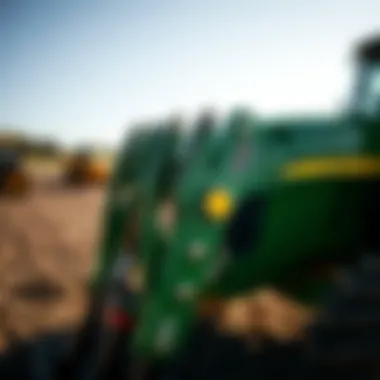
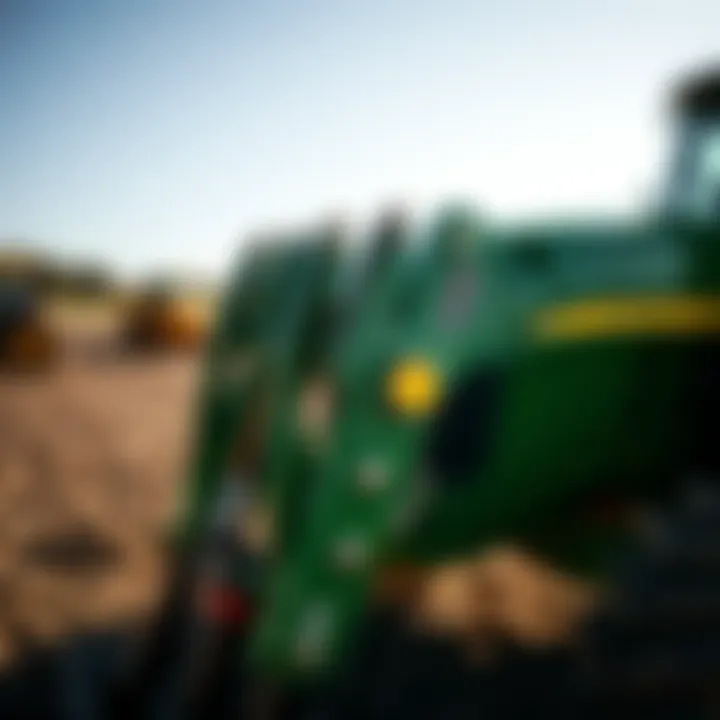
Types of John Deere Forks
Understanding the various types of John Deere forks is essential for maximizing efficiency in agricultural and industrial settings. Each type serves a specific purpose, tailored to different tasks and operational needs. Recognizing the right fork type for the job can enhance productivity, reduce the risk of equipment damage, and promote safety while handling materials. This section will dissect the main categories of forks offered by John Deere, emphasizing their features, advantages, and suitable applications.
General Purpose Forks
General purpose forks are the versatile workhorses of the John Deere fork line. They are designed to accommodate a multitude of handling tasks, making them suitable for both agriculture and general lifting purposes. With a robust construction, these forks often feature adjustable tines, allowing users to adapt them to different loads and sizes.
Some of the key benefits of general purpose forks include:
- Versatility: Their design allows them to handle various materials like hay, pallets, or loose loads.
- Ease of Use: Many general-purpose forks attach directly to tractors or loaders, streamlining operations.
- Cost-Efficiency: With their multifunctional capabilities, they minimize the need for multiple attachments, saving money in the long run.
Bale Forks
Bale forks are specially designed for handling large round or square bales, making them indispensable for livestock farmers and those involved in hay production. These forks typically include features tailored to securely grip and lift bales without damaging them.
When using bale forks, consider:
- Tine Length: Longer tines can better penetrate and stabilize larger bales, ensuring safe lifting.
- Weight Distribution: Proper alignment and spread of weight can prevent accidents and enhance ease of transport.
- Compatibility: Ensure that the bale forks are compatible with the specific John Deere model you are using to maximize functionality.
Palett Forks
Palett forks, designed specifically for handling palletized goods, are essential for warehouses and transport businesses. Their design focuses on easily slipping underneath pallets while maintaining stability during lifting.
Benefits of pallet forks include:
- Efficiency: These forks are engineered to quickly transport pallets, reducing the time spent on manual handling.
- Durability: Built from high-quality materials, they can withstand the wear and tear of heavy-duty operations.
- Precision: Some models feature adjustable forks, allowing for precision when inserting under various pallet sizes.
Grapple Forks
Grapple forks are a blend of forks and grapples, effectively combining the benefits of both for handling bulk materials like logs, brush, or debris. They secure loads firmly, giving the operator enhanced control during transport.
Key considerations for using grapple forks include:
- Load Control: The grapple attachment can stabilize loose materials, making it easier to transport without spills.
- Customization: Some versions allow the operator to adjust the configuration, making them adaptable for different material types.
- Operational Range: With extended reach, grapple forks can access materials in hard-to-reach places, streamlining operations in various environments.
"Choosing the right fork type can dramatically impact efficiency and safety in operations, making it a crucial decision for any operator."
Each of these fork types carries its unique set of advantages and is engineered to meet specific operational demands. Whether enhancing an agricultural setup or supporting industrial tasks, understanding the differences among John Deere forks will lead to better decision-making and improved productivity.
Key Features and Specifications
The key features and specifications of John Deere forks play a significant role in determining their utility and effectiveness in both agricultural and industrial settings. Understanding these features helps to gauge the quality and suitability of these tools for different tasks. Each fork type is designed with specific characteristics that cater to unique tasks, making it essential for buyers to be well-informed before making a purchase.
Construction Materials
The construction materials used in John Deere forks directly influence their durability and performance. Typically, forks are crafted from high-strength steel, which provides the necessary strength to withstand heavy loads while maintaining a manageable weight. It's worth noting that some forks may incorporate high-carbon steel for even greater resilience. This choice of materials is not merely for show; it speaks volumes about the expected lifespan and reliability of the product.
- High-Strength Steel: Enables the forks to handle significant weight without bending or breaking.
- Resistance to Wear: Materials selected often have enhanced wear resistance, especially when used in rugged environments.
- Corrosion Protection: Many forks come with a protective coating to prevent rust and deterioration, extending their service life.
Considering the materials is not just about strength, but also about how they will perform in specific weather conditions. For instance, forks intended for outdoor agricultural operations need to resist not only the wear-and-tear of frequent use but also environmental factors like rain, snow, or heat.
Load Capacity and Size Variations
When evaluating John Deere forks, another pivotal aspect is their load capacity and size variations. Different tasks require forks with different load capabilities. Using a fork that cannot adequately handle the weight can lead to not only damaged equipment but potential safety hazards as well.
- Load Capacity: Standard forks may handle loads ranging from 1,000 to over 3,000 pounds, depending on the type. Knowing the load limit is crucial for safe operations.
- Size Variations: Forks come in various lengths and widths, allowing users to select the optimal size for their specific needs. For example, a longer fork may be more suitable for handling big bales of hay, while shorter ones may excel in maneuverability within tight spaces.
- Versatility in Applications: Understanding these dimensions enables users to adapt forks for tasks like lifting pallets, moving bulk materials, or stacking items efficiently.
"Choosing the right fork size for the job not only enhances efficiency but also safeguards against damage and accidents."
Each of these specifications contributes to the overall functionality of John Deere forks, making them integral to farming and industrial operations. Decisions in this realm should be made with careful consideration of how these features align with the intended use, ensuring that the right tool is in hand for the right job.
For more intricate details about different specifications or to compare models, visiting official websites or trusted agricultural equipment platforms is advisable.
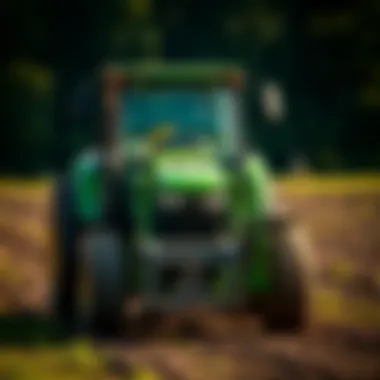
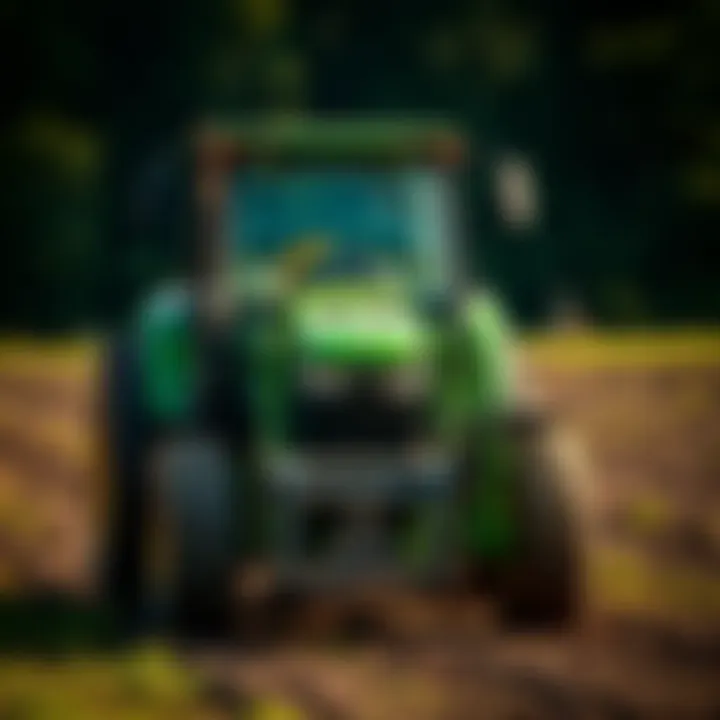
Compatibility with John Deere Machinery
Understanding how John Deere forks integrate with various types of machinery can significantly enhance operational efficiency in agricultural and industrial settings. This compatibility not only affects functionality but also ensures safety and optimal performance. Each John Deere fork is designed with specific machinery in mind, fostering a seamless connection that maximizes the overall effectiveness of each piece of equipment.
When we think about compatibility, the connecting mechanisms and attachment systems take center stage. John Deere forks are engineered to attach effectively to tractors and loaders, creating a user-friendly experience that is essential for day-to-day tasks. For farmers and operators, knowing which forks are suited for their machinery can save time and reduce wear and tear on equipment by ensuring a proper fit and function.
Connecting Forks to Tractors
Connecting forks to tractors is not just about simply attaching one piece of equipment to another. It's a meticulous process that demands an understanding of both the machine and the attachment. The mounting systems help firmly secure the forks, ensuring stability throughout the lifting process.
- Attachment Types: John Deere employs a variety of attachment types, such as pin-type and hook-type connections. Knowing which one fits your tractor is crucial, as the wrong fit can lead to operational inefficiency or even accidents.
- Weight Distribution: Proper connection of forks aids in maintaining balance while lifting heavy loads. A fork improperly attached can shift unexpectedly, posing a safety hazard. Therefore, operators must always check for a secure fit before commencing any lifting operations.
- Ease of Use: John Deere designs its forks with user-friendly attachments, allowing operators to switch between forks and other implements without too much hassle. This adaptability promotes efficiency on the job site—an essential factor for successful farming and industrial applications.
The focus on user-centric designs is not merely a convenience; it reflects the insights gained from decades of experience in the field, emphasizing the need for robust solutions in demanding work environments.
Fork Attachments for Loaders
Similarly, the situation with forks used in loaders warrants attention. These attachments play a vital role in extending the functionality of loaders, allowing them to handle various materials beyond simple soil or debris. Here’s why selecting the correct fork attachment is a game changer:
- Enhanced Versatility: Loader forks can lift bales, pallets, or logs, which means farmers and contractors can accomplish multiple tasks with one piece of machinery. This flexibility translates to reduced operational costs and time savings.
- Load Capacity: Different loader setups can accommodate forks with varying load capacities. It is imperative to match the fork’s specs to the loader's capabilities to prevent overloading and maintain machine integrity.
- Quick-Change Systems: Many of today’s loaders are equipped with quick-change systems, making it straightforward to swap forks without tools, so operators can keep the workflow uninterrupted. This feature allows for rapid transitions between tasks, facilitating higher productivity.
A careful consideration of these elements ensures that John Deere forks function at peak efficiency, making an operator’s job more manageable while enhancing safety protocols in the process. Ultimately, the compatibility of forks with John Deere machinery is not just a matter of fitting parts together but optimizing the entire operation for peak performance and safety.
"Well connected, well operated; machinery works best when every piece fits just right."
Operational Considerations
Operational considerations play a crucial role in optimizing the use of John Deere forks, ensuring that tasks are carried out efficiently and effectively. These factors encompass best practices for handling materials with forks, as well as adhering to safety protocols. Both elements are indispensable for maximizing productivity while minimizing operational risks. Without proper attention to these considerations, the likelihood of accidents, equipment damage, or operational slowdowns increases significantly, which is something agricultural farmers and industry enthusiasts cannot afford.
Best Practices for Loading and Unloading
When it comes to loading and unloading using John Deere forks, following best practices is key for ensuring smooth operations. Here are some prime practices:
- Load Distribution: Always distribute the load evenly across the forks. Imbalance can lead to unsafe lifting conditions, increasing the risk of dropping or tipping the load.
- Fork Positioning: Adjust the forks to the proper width for the load being lifted. If you’re dealing with pallets, make sure they are snugly held without pinching them too tightly.
- Speed and Control: Avoid rushing during loading and unloading. Maintaining a steady speed allows for better control, reducing the chances of accidents or materials falling during transport.
- Securing Loads: Whenever feasible, secure loads using straps or chains to keep everything in place during transport. This is especially important for uneven or shifting materials.
- Communication: Establish clear communication among the team members. Use hand signals or radios to ensure everyone is on the same page while working.
Implementing these best practices can vastly improve the overall efficiency of operations while using John Deere forks.
Safety Protocols when Using Forks
Safety cannot be taken lightly when using John Deere forks. Addressing every aspect of safety protocols ensures both the operators and the bystanders are protected while work is underway.
- Personal Protective Equipment (PPE): Operators should always wear adequate PPE such as helmets, gloves, and steel-toed boots. Being prepared for potential hazards is non-negotiable.
- Regular Training: Operators should undergo regular training sessions to keep up with safety practices and equipment operation. This helps in building confidence and competence.
- Responsibility Awareness: Operators must be aware of their surroundings and any potential hazards. This includes being conscious of other workers and vehicles in the vicinity.
- Fork Inspection: Prior to each use, inspect the forks for any wear, damage, or malfunction. Ensure that the mechanisms for securing and releasing are functioning properly.
- Avoid Overloading: Always adhere to the manufacturer's load capacity guidelines. Overloading can not only damage the forks but also lead to catastrophic failures during lifting.
Proper execution of safety protocols can drastically reduce accident rates in workplaces and enhance overall operational effectiveness.
Maintenance of John Deere Forks
Maintaining John Deere forks is not just a task; it’s an essential aspect of ensuring their longevity and efficiency. Regular upkeep can make a world of difference, especially in agricultural and industrial contexts where these tools often encounter harsh conditions. The benefits extend beyond just performance; proper maintenance can save time and money in the long run. This section will provide insights into the routine checks needed to keep forks in prime condition as well as guidelines for storing them effectively.
Regular Inspections and Repairs
Conducting regular inspections is the cornerstone of fork maintenance. This not only includes visually checking the forks for any cracks or signs of wear but also extends to functionality assessments. Here are some crucial points to consider:
- Visual Inspection: Check for physical damage such as bends or dents. Even a minor crack can lead to significant failures under stress.
- Functionality Test: Attach the forks to machinery and ensure operational efficiency. Movement should be seamless without wobbling or jarring.
- Lubrication: Grease moving parts as it plays a vital role in reducing friction, preventing premature wear, and ensuring smooth operation.
- Wear Indicators: Some forks come equipped with wear indicators—these are often overlooked but provide vital information on the effective life of the forks.
It’s best practice to schedule these inspections on a regular basis, ideally after every significant use or shift in heavy-load conditions. Not only does this keep operations safe, but it also helps in identifying potential issues before they turn into substantial problems, ensuring your equipment remains reliable.
"A stitch in time saves nine". Regular maintenance can prevent larger expenses down the line, confirming the age-old adage.
Storage Guidelines to Extend Life
When it comes to keeping forks in good shape, where and how you store them can make a notable difference. Here are a few recommendations on effective storage methods:
- Clean the Forks First: Before storing, ensure that all dirt, grease, and residues are cleaned off. Residues can cause corrosion over time.
- Dry Environment: Store forks in a dry place to prevent rust formation. This may mean considering a storage facility that’s covered or using a protective tarp if outdoors.
- Avoid Pressure on Forks: Ensure that forks are not resting under pressure when stored. Supporting them properly will help maintain their shape and function.
- Regularly Rotate and Inspect: If forks are stored for an extended period, it’s wise to rotate their position occasionally. This prevents permanent distortions and allows for inspections.
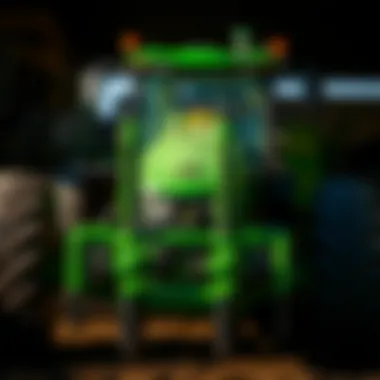
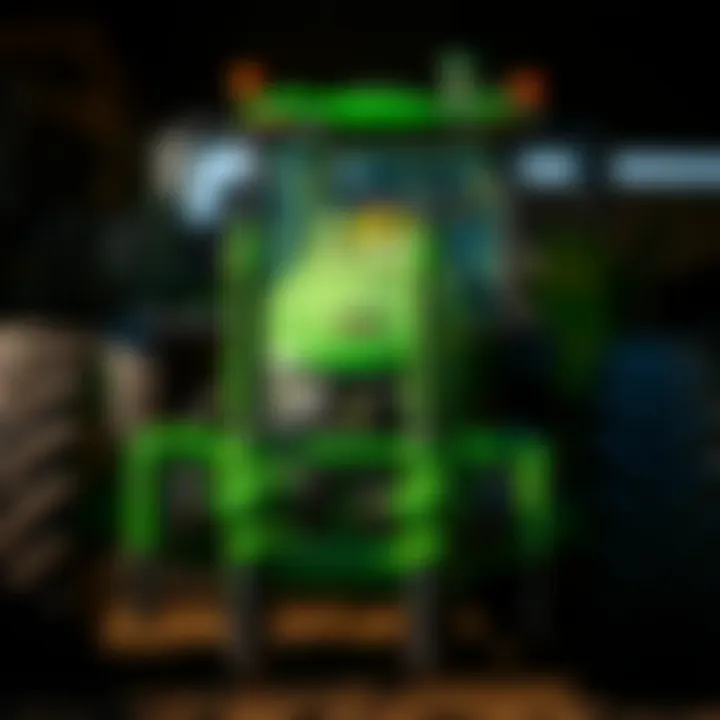
By following these storage guidelines, you can significantly enhance the life expectancy of your John Deere forks. Keeping them in optimal conditions will undoubtedly prolong their usability, making future work smoother and more efficient.
Overall, maintenance is critical in ensuring that John Deere forks perform at their best. By incorporating regular checks and adopting smart storage practices, you’ll be investing in both performance and longevity.
Technological Innovations
The field of agriculture and industry is continuously evolving, with technological innovations playing a pivotal role. Among these advancements, the integration of technology into John Deere forks has not only revolutionized their functionality but also dramatically improved operational efficiency. Understanding these innovations is essential for anyone involved in agricultural practices or industrial applications, as they translate into significant economic benefits and productivity enhancements.
With the rise of smart machinery, John Deere forks are now offered with features that allow for seamless communication between equipment and operators. These upgrades enable users to gain valuable insights into the loading and unloading processes, which ultimately leads to informed decision-making in the field.
"Adopting new technologies in farming is not just about keeping up with trends; it's about staying ahead in a competitive market."
Smart Fork Integration
In recent years, the concept of smart fork integration has gained traction, aiming to make the most out of John Deere's robust fork systems. This technology typically involves sensors that track the location of the forks and the load capacity in real-time.
- Enhanced Monitoring: With real-time data accessible on mobile devices or control panels, operators can monitor weight distribution, ensuring that loads adhere to safety regulations and prevent equipment damage.
- Increased Efficiency: These smart systems can be programmed to automate specific tasks, reducing the time spent on mundane operations. For instance, when loading bales, the forks can be set to lift to optimal heights without manual adjustments.
- Data Collection and Analysis: By collecting historical data through smart forks, farmers can analyze their operations over time, leading to refined processes and resource allocation that can increase yield.
Enhancements in Load Monitoring Systems
Load monitoring systems have taken a leap forward, easing the burden of ensuring safety and efficiency on the job. These advancements, tailored for John Deere forks, offer remarkable benefits that are hard to overlook.
- Weight Sensors: Equipped with sensors, these forks can measure the weight of the load being lifted. This ensures that the carry limits are respected, preventing potential accidents and equipment breakdowns.
- Alerts and Notifications: Modern systems come with alerts that notify operators if they’re approaching weight limits or if a fault is detected in the fork alignment. This proactive approach helps mitigate risks before they escalate.
- User-Friendly Interfaces: Most load monitoring systems are designed with ease of use in mind. Operators may find screens that display current load conditions, previous weights, and even graphical layouts of load distribution—everything accessible in a glance, simplifying management on-site.
In summary, the synergy between technological innovations and John Deere forks marks a new era of operation that prioritizes safety and productivity. As farms and industries seek greater efficiency, understanding and adopting these technologies becomes invaluable for sustained growth.
Case Studies of John Deere Fork Usage
Examining real-world examples of John Deere forks in action provides invaluable insights into their diverse applications and effectiveness. Case studies not only demonstrate the versatility and reliability of these tools but also shed light on best practices, operational hurdles, and unique solutions tailored for different environments. These detailed investigations are critical for both current users and potential buyers, helping them make informed decisions while enhancing productivity on farms and in factories.
Successful Implementations in Large Scale Farms
Large scale farms often require heavy-duty equipment that can stand the test of time. John Deere forks have been an integral part of many success stories in such settings. For instance, consider a sprawling wheat farm in Kansas that adopted John Deere grapple forks. By integrating these forks into their daily operations, they improved efficiency in handling grain deliveries.
- Increased Productivity: With the ability to lift and transport larger loads, farmers were able to reduce the number of trips needed to deliver crops to storage silos. This efficiency ultimately saved time and labor costs.
- Enhanced Versatility: The farm also utilized John Deere's general purpose forks seasonally to handle bales of hay during spring and summer months. This adaptability allowed for seamless transitions during peak operational periods.
- Cost-Effectiveness: Investment in John Deere forks resulted in a significant decrease in equipment breakdowns, leading to lower maintenance costs and increased uptime.
Farm managers noted that the improved load capacity not only made day-to-day operations smoother but also contributed positively to their bottom line. Such implementations exhibit the real-world impact and reliability of John Deere forks on large scale agricultural setups.
Forks in Industrial Environments
Beyond agriculture, John Deere forks have made significant headway into industrial environments, asserting their presence in warehouses and manufacturing plants. Take the case of an automotive parts manufacturer in Michigan that integrated these forks into its assembly line. By using John Deere palett forks for transporting parts, the operation saw impressive improvements.
- Streamlined Processes: The smooth connection to their existing John Deere loaders allowed for quick attachments, facilitating rapid material handling during peak production periods.
- Safety Improvements: Reliability is key in industrial settings. The design of John Deere forks minimizes tipping risk even under heavy loads, thus enhancing workplace safety for employees.
- Durability Trends: Operating in rigorous environments, these forks showcased superior durability against wear and tear. Regular maintenance schedules ensured that they remained in top shape, leading to reduced operational disruptions due to equipment failure.
The adaptability of John Deere forks in both agricultural and industrial situations highlights their importance. They not only contribute to efficiency and safety but also stand testament to how evolving environmental needs can be met with effective tools.
Investing in reliable equipment can transform operations, boosting both productivity and employee safety in various sectors.
By analyzing these case studies, it is evident that John Deere forks are not merely tools; they are pivotal assets that can enhance operational capabilities across a wide range of industries.
End and Future Outlook
As we wrap up our exploration into John Deere forks, it's essential to recognize the significance of the insights gained and how they will influence both current and future practices within the agricultural and industrial landscapes. The findings laid out in this article not only shed light on the functional prowess of these forks but also paint a vivid picture of their evolution and ongoing relevance in a rapidly advancing world.
Summary of Key Insights
Throughout this discussion, we’ve unpacked a range of attributes associated with John Deere forks, encompassing their historical significance, versatility across various applications, and the robustness of their construction. Some key points include:
- Diverse Types: From general purpose to grapple forks, each has a unique role, tailored to specific tasks which enhance efficiency in loading and transferring materials.
- Compatibility with Machinery: Ensuring that forks align with John Deere machinery allows for seamless operations, maximizing productivity while minimizing downtime.
- Technological Integration: The incorporation of smart technologies not only streamlines operations but also paves the way for innovations that anticipate user needs in real-time.
These insights highlight just how integral John Deere forks are to effective agricultural and industrial operations. They serve as facilitators of productivity, safety, and ultimately, profitability for users across the spectrum.
Predictions for Innovations and Trends
Looking ahead, the trajectory of technology in the realm of forks is poised for significant advancement. Some predictions include:
- Enhanced Smart Features: We may see a rise in AI-integrated forks; think about sensors that can gauge load weight and balance for optimized handling. This could help in reducing accidents, conserving resources, and promoting environmental sustainability.
- Materials Development: As industries strive for lightweight yet strong equipment, innovations in materials science might lead to forks that are both incredibly durable and easy to handle. This could drastically change how farmers and operators perceive load management.
- Focus on Sustainability: With a growing awareness of ecological challenges, future designs could place more emphasis on sustainable production methods and recyclable materials, aligning with broader initiatives in agriculture towards a greener future.
In summary, John Deere forks remain a critical element of modern farming and industrial practices. Anticipating future changes and enhancements will prepare users not only to adapt to new technologies but also to lead in the ever-evolving landscape of agriculture and efficiency.







